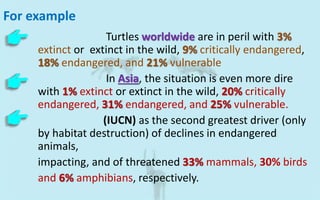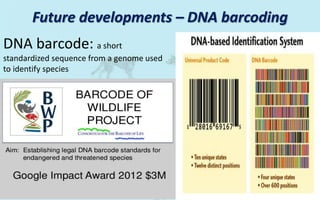Wildlife forensics applies scientific principles to investigate and prosecute wildlife crimes, which include illegal poaching, possession, and trade of endangered species. The field involves various branches of science, including molecular biology for DNA analysis to identify species and determine the legality of animal products. Wildlife forensic laboratories, such as the national fish and wildlife forensics laboratory, utilize advanced techniques to analyze evidence from crime scenes and support conservation efforts amid the growing global threat of wildlife trafficking.

















































































![RAPD band pattern for H. huso, A. stellatus and A. gueldenstaedtii
[modified after Barmintsev et al., (2001)]](https://image.slidesharecdn.com/wildlifeforensics-151218055748/85/Wild-life-forensics-82-320.jpg)







